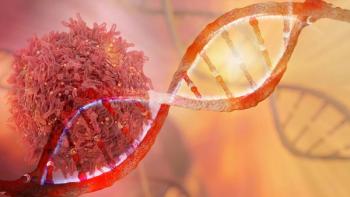
Oncology NEWS International
- Oncology NEWS International Vol 6 No 8
- Volume 6
- Issue 8
Thalidomide, Paclitaxel, and Vinorelbine Tested in Kaposi's Sarcoma
BETHESDA, Md--Thalidomide, paclitaxel (Taxol), and vinorelbine (Navelbine) have all shown promise in phase II trials as treatment for Kaposi's sarcoma in AIDS, researchers reported at the National AIDS Malignancy Conference. Although progress has come in treating KS, more effective drugs are needed, especially in light of the lengthening life span emerging for AIDS patients from the use of drug combinations.
BETHESDA, Md--Thalidomide, paclitaxel (Taxol), and vinorelbine (Navelbine)have all shown promise in phase II trials as treatment for Kaposi's sarcomain AIDS, researchers reported at the National AIDS Malignancy Conference.Although progress has come in treating KS, more effective drugs are needed,especially in light of the lengthening life span emerging for AIDS patientsfrom the use of drug combinations.
"We now have the apparent luxury to manage Kaposi's sarcoma overyears rather than months," said Susan E. Krown, MD, of Memorial Sloan-Kettering.
The rationale for testing thalidomide stems from its three possiblemechanisms of action against KS, said Mark Bower, MD, PhD, of Chelsea &Westminster and Charing Cross Hospitals, London.
The drug selectively inhibits the synthesis of TNF-alpha, an autocrinegrowth factor in KS; it has antiangiogenic activity in vivo; and it reducesHIV-1 activation in peripheral blood mononuclear cells in vitro. Moreover,two case reports indicate beneficial effects from thalidomide in peoplewith KS.
Dr. Bower and his colleagues carried out a phase II study in 17 HIV-positivemales (median age, 40) with histologically documented Kaposi's sarcoma.Patients had a median CD4 count of 34. All were taking antiretroviral therapy,but none were on protease inhibitors.
The researchers collected a peripheral blood sample before treatmentand at four weeks into the therapy, and evaluated each patient's DNA burdenof human herpesvirus-8 (HHV-8), thought to be the cause of KS in AIDS patients.
Study participants received 100 mg of thalidomide administered orallyeach night for eight weeks, a dosage the researchers had used in a previoustrial.
Nine patients completed the study. Eight dropped out: one because ofpoor compliance, one due to progressive disease, and six because of toxicity.Four of the toxicity dropouts suffered a rash that spontaneously resolvedwithin 24 hours of stopping thalidomide; one developed Raynaud's syndrome,the other nausea.
Six of the nine remaining patients had a partial response, Dr. Bowersaid. Five of the six had detectable HHV-8 at enrollment; and four of thesefive showed a decline when tested in the midst of the trial, includingthree who had no detectable HHV-8. "We've shown that thalidomide hasbiological activity in this disease and that response is associated witha decline in HHV-8," he said.
Similar promising results emerged from a
KS Cell Lines Sensitive to Taxol
Dr. Gill and his colleagues conducted preclinical studies of the drugand found that KS cell lines were very sensitive to paclitaxel, "assensitive as any cell line that has been studied so far," he said.
The team treated 54 male and two female AIDS-KS patients (median age,36), most with advanced disease. The median CD4 count was 20. Forty patientshad undergone chemotherapy or biological response modifier treatment; 16had received no prior systemic therapy. Twenty-five patients (45%) hadvisceral disease--16 involving the lung and GI tract. Lymphedema affected39 (70%).
The patients received 100 mg/m² of paclitaxel administered overthree hours every two weeks. The median number of cycles completed was10, with a maximum of 22. Side effects included hair loss, neutropenia,and anemia.
Responses were seen in 59% of patients, including one complete response;25% had stable disease; 16% progressed. The median time to response was1.5 months, but one patient did not respond until 9 months.
The median response duration was 10.4 months, "which is the longestduration of response that I'm aware of in any trial conducted so far,"Dr. Gill said. "The survival curve is also unprecedented. The mediansurvival is 23.8 months." These findings, Dr. Gill concluded, warranta randomized trial of paclitaxel in AIDS-Kaposi's sarcoma patients.
Vinorelbine (Navelbine), a semisynthetic vinca alkaloid, also showedpotency against KS in a phase II trial involving 29 male patients (medianage, 36), said Michele Spina, MD, for the Italian Cooperative Group onAIDS and Tumors.
Patients in the study had advanced KS and CD4 counts ranging from 1to 351 (median, 16). All had either relapsed after previous chemotherapyor progressed during previous cytotoxic therapy. They received 30 mg/m²of vinorelbine given IV every two weeks. Two patients were lost to follow-up.The median number of cycles completed was four.
Three CRs With Vinorelbine
Of the 27 patients evaluated, three had complete remissions, with durationsof 5, 8, and 15 months Dr. Spina said. Another nine, had partial remissionsthat lasted one to six months (median duration, three months). All 12 respondershad previously failed vinca alkaloid therapy. Nine other patients had stabledisease, and six had progressive disease.
Thirteen patients suffered grade 3 or 4 leukopenia; two had anemia;one experienced thombocytopenia. No neurotoxicity was observed, Dr. Spinasaid.
Seventeen have now died; median survival is seven months, eight monthsfor responders versus five months for nonre-sponders. "We think vinorelbineis active and well tolerated," Dr. Spina said. "And we thinkit should be considered also for studies as a first-line single agent oras a component of combination chemotherapy regimens for KS patients."
Articles in this issue
over 28 years ago
Two-Step Approach Urged to Avoid High Tech, Wild Deathover 28 years ago
Health Insurance Premiums Tax Proposedover 28 years ago
ODAC Votes Yes on Taxol for Kaposi's Sarcomaover 28 years ago
Five Principles Help Resolve Ethical Dilemmas in Careover 28 years ago
Ovarian Cancer Survivors Form National Coalitionover 28 years ago
Photodynamic Therapy Used in Nonmelanoma Skin Cancerover 28 years ago
Increased Numbers of Nevi Can Predict Risk of Melanomaover 28 years ago
With Genetic Tests, Informed Consent Enters Psychosocial Realmover 28 years ago
Cryoablation May Have Limited Role in Prostate Cancer Treatmentover 28 years ago
Americans Not Convinced of Value of Watchful WaitingNewsletter
Stay up to date on recent advances in the multidisciplinary approach to cancer.
































































































